 Leading Blog | Posts by Month |
 Leading Blog | Posts by Month |
03.31.11

LeadershipNow 140: March 2011 Compilation
Posted by Michael McKinney at 08:30 AM
03.28.11

Heritage and Innovation: Finding the BalanceIn times of change there is the tendency to either stick doggedly to what has always worked in the past or to throw it all out and start new. Neither extreme is the answer.Heritage and innovation is a tension that needs to be managed—thoughtfully. Our default thinking is to view the world in terms of what has worked before so we often fail to address the changes going on around us. As a result we tend to lose our influence. At the same time, to overhaul everything without regard to our roots—our traditions, our heritage—can take us away from why we began doing what we are doing in the first place. Howard Schultz recognized as he began to deal with Starbuck’s identity crisis in 2008 that they had to strike a delicate balance between heritage and innovation. In Onward he writes: “I understood that we had to return to our roots, but if that heritage was not linked to a willingness to reinvent and innovate, then we would fail.” Our heritage is the repository of our values and unshakable truths. Applying them to a changing world makes them relevant. But how to go about this is not always self-evident. As we naturally view what we do through the lens of what has worked before, it is hard to envision a different world. If we don’t learn to apply them to what is happening today, they begin to look worn and outdated to the present world. We have to begin by asking, “What is Truth (for us) and what is habit?” Truths are maintained. Habits can be adapted. 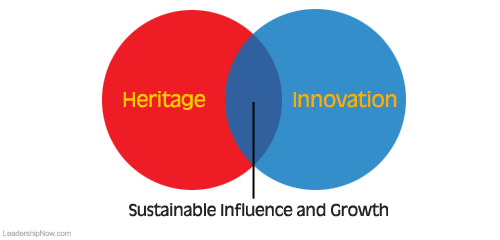
We need to learn to translate our heritage into a meaningful direction aligned to the present situation. Heritage either stands the test of time or it is a fad. Change for change sake, is faddish. Sustainable influence and growth is achieved when heritage and innovation overlap. Innovation should be informed by heritage which is in turn, made relevant by it. Change is essential to growth. More than anything else, fear keeps us from making necessary changes. Fear of the unknown. “What will happen?” Innovation rocks the boat. It creates instability, yes, but the kind of instability needed for growth. If we don’t make heritage relevant by innovation we can stunt growth and diminish our influence. We actually aid people’s ability to cope and thrive in a changing world when we find ways to change what we do without changing who we are. Heritage and innovation is an ongoing tension that needs to be managed.
Posted by Michael McKinney at 07:46 AM
03.25.11

The Steve Jobs Way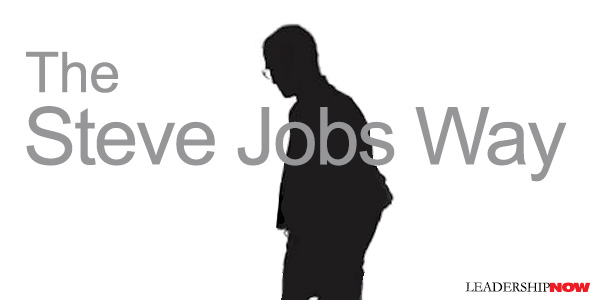
APPLE is on a roll and we want to know how Steve Jobs does it. The Steve Jobs way is, in a word, passion. Passion drives his perseverance and momentum through setbacks.
Jobs succeeds because he follows his passions. “He understands the mindset of the people he wants to create products for because he is one of them. And because he thinks like his future customers, he knows he has seen the future.” At the same time, Jobs does not rely on focus groups. That might be good for incremental change, but to “make a dent in the universe,” you need people who focus on what the experience could be. Elliot says Jobs loved to quote Henry Ford: “If I had asked my customers what they wanted, they would have told me, ‘A faster horse.’” Not only is Jobs enthusiasm infectious, but he thinks regularly about how to build enthusiasm. At Apple, meetings were driven by ideas and those who had them and were not dictated by hierarchy as in most organizations. “He knows that you have to become the product to lead well. He finds powerful ways to make certain every employee is convinced that he knows their contribution is essential to the product’s success.” Innovation is a group activity at Apple. “Imagine,” says Elliot, “working on a product so desirable that the members of the development team can hardly wait to finish it so they could each have one of their own.” One-time Apple executive Jean-Louis Gassé endorsed Steve’s management style with a memorable phrase: “Democracies don’t make great products—you need a competent tyrant.” People who worked for Steve forgave him, or at least tolerated his style, in part because, more than anything else, he was a product tyrant, totally dedicated to delivering the products he envisioned. Jobs is the ultimate user. Everything is designed around the customer experience. Former employee Donna Dubinsky recalled a decision Jobs made that illustrates this value: We were moving from 300 dpi printers to 1200 or something—some generational shift. What to do with the old inventory? You cut the price and blow them away. You make money from customers who want the bargain. From watching the Apple/Jobs split in 1985 first-hand, Elliot saw that “learning how to make yourself understand, learning how to be persuasive, is critical for a business leader.…It was an object lesson in what happens when a company does not have a cohesive product strategy and is organized functionally instead of in distinct product groups.” Elliot’s appraisal of Steve Job’s leadership is helpful for anyone wanting to get a better look “behind the curtain” from someone who was there and worked closely with Jobs. The perspective is valuable. The stories and anecdotes alone are worth the time. Elliot recounts an interview Jobs had with Daniel Morrow on what it takes to be an entrepreneur: “I think you should go get a job as a busboy or something until you find something you’re really passionate about.” He believes that “about half of what separates the successful entrepreneurs from the non-successful ones is pure perseverance. 
Posted by Michael McKinney at 07:14 AM
03.24.11

Leading Views: Getting Another Perspective In The Velocity Manifesto author Scott Klososky reminds us of the importance of getting another perspective: In The Velocity Manifesto author Scott Klososky reminds us of the importance of getting another perspective:
When I was CEO out building my technology companies, I never realized how limited my thinking was until I became a consultant and speaker. When you go to the same office and are surrounded by the same people every day, and you are thinking about solving the same problems over and over again, you invariably become a bit myopic. Only by getting away from your usual world and observing other, very different environments can you build the skill of assimilating ideas from other industries into your own. Perspective is a powerful thing, and looking at the world through the eyes of another industry is a great move. Of Related Interest:
Posted by Michael McKinney at 10:42 AM
03.21.11

What's Holding You Back? A Call for Gutsy Leadership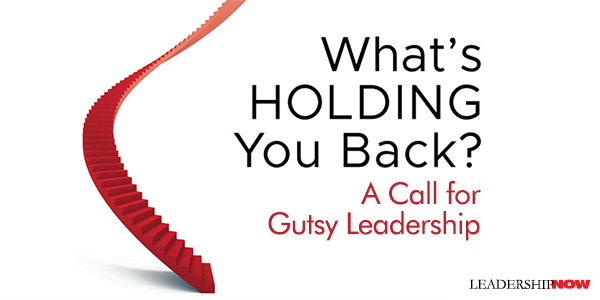
ROBERT HERBOLD, former COO of Microsoft, says that lack of courage is what destroys companies. In example after example, what is holding companies back is consistent, courageous leadership. In What’s Holding You Back? he writes that we need gutsy leaders that “make sure that their organization has a simple, understandable, clear game plan for the future,” a culture that is “curious, even paranoid about the future, to keep people always looking for new ways to help the company grow and prosper,” they “make sure decision making is crisp and accountability is clear.” Management that doesn’t confront problems and make the necessary tough decisions to change, typically ends up with a culture focused on pride in the past and the protection of old procedures. I think we are seeing too much of this core issue, and what we end up with is operational complexity and lack of innovation and forward momentum. Herbold says that this is usually due to one or more of the following reasons: Avoid conflict
Herbold details ten principles that you should review regularly to help you provide gutsy, courageous leadership. The most important principle and the one underlying the rest is the first principle: Devise a Demanding Game Plan to Confront Reality. This is accomplished by putting three things in place: “a clear vision with impact, aggressive strategies to achieve that vision, and a defined way of measuring success. Echoing Max De Pree, Herbold writes, “The core job of a leader in any organization is to quickly and accurately assess the current situation and any vulnerabilities and opportunities the organization may have.” He adds, “The leader must then lay out a demanding game plan…and stand ready to modify that plan at any moment, given new learning.” The process of creating aggressive strategies to achieve that vision should be “very interactive and fact-driven, and it can become an engaging and exciting venture for the organization.” Finally, appropriate measures should be defined to tell everyone whether or not the vision has been achieved. What’s Holding You Back? is valuable for reminding us of basic principles that are easily overlooked as we get caught up in the daily minutia. Another part of defining reality that I think is significant enough to mention is understanding our impact on those around us. It’s not uncommon to find that we hold others back because of remarks we make, and as a result, we lose the full potential of what they bring to the table. In a section titled “Creativity and Six Sigma don’t Mix,” Herbold writes: Innovation is not an orderly process. People who are good at it tend to go through many ideas before coming up with one that works. It’s also a very fragile process. A manager can stifle innovation without even knowing it through his or her unspoken communications. People who are charged with innovation are constantly observing how their management is acting and reacting. Unfortunately, they often interpret their management’s behavior and casual comments as specific instructions or constraints that need to be followed. As we need to consistently ask, “What’s holding me back?” we also need to ask, “How am I holding others back?” 
Posted by Michael McKinney at 10:50 PM
03.18.11

5 Leadership Lessons: The Velocity Manifesto In today’s high-velocity environment, Scott Klososky believes you need to understand how to guide your organization in the implementation and usage of technology—in short, how your organization “does” technology. [As a leader], you—not the IT department, nor the VP of IT, nor the chief information officer (CIO)—must understand, drive and be accountable for how technology is structured in order to reach the strategic goals of the operation….Technology enables velocity—the speed of getting products to market, the speed of delivery, the speed of analytics, and the list goes on. Speed is our friend in almost every case. An organization’s digital plumbing is what facilitates this speed, and it has become the single most important variable for success in many organizations.The Velocity Manifesto 
Posted by Michael McKinney at 04:54 PM
03.15.11

How Did They Get Ten Steps Ahead of the Rest of Us?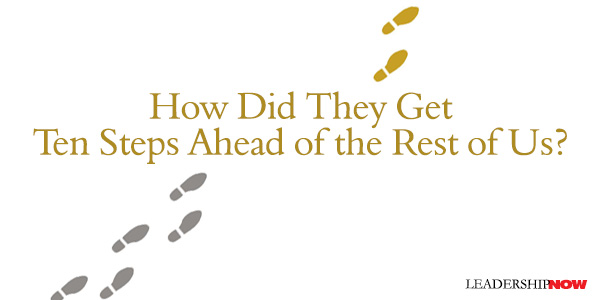
ERIK CALONIUS wants to know what makes a visionary? What allows a Steve Jobs, Walt Disney, Berry Gordy, John Lennon, Richard Branson, and others like them, to do what they do? How do they see what the rest of us are missing? Blending cognitive psychology, neuroscience and (mostly) first-hand accounts of the visionary’s life, in Ten Steps Ahead, he builds a picture of what makes them tick. He identifies the importance of intuition and emotional intelligence and the role of courage and conviction in separating visionaries from mere dreamers.“Visionaries don’t succeed by lying in bed with their dreams floating idly by above their heads. They get out into the world and experience things, and from that, shape their ideas.” It’s being a first-class noticer as Warren Bennis suggested. Calonius cites Thomas Kuhn’s work on paradigm shifts and the years of “mopping up” that follow them. Julian Huxley wrote in 1957, “Once science has reached the stage of having a coherent theoretical basis, it will inevitably proceed … to make further discoveries and further extension of its theory.” Calonius explains: That’s why commercial products often follow scientific breakthroughs by about 20 years or so. … “First movers,” in other words (and contrary to the mantra of the “New Economy” of the late 1990s), very often do not prevail. This means you don’t need to deliver the paradigm to mop up quite successfully in its aftermath. You don’t even need to be the first mover. Just be clever enough to make off with the flotsam of the paradigm after it has crashed upon the shore. The reoccurring insight I find in these pages is that it really comes down to the ability (and confidence) to walk a fine line, to develop a balance of thought. For example, pattern recognition allows visionaries to make connections and see what is not yet seen. Yet at the same time, pattern recognition can lock us into a constrained view of life of our own making. “The same patterns that help us predict the future are also the ones that lock us into the present.” Calonius observes, “Intuition is essential to the visionary. Visionaries almost always work at the edge of our understanding, where information is scarce or nonexistent and where intuitive decisions are often the only choice.” But again, there’s a balance. If we follow our intuition blindly, we can lose it all. “Intuition is a judgment call” that must be developed. “Practiced insight, leavened with intuition.” Emotional intelligence is also an important element. It is “that rare balance between dry logic and emotional intuition.” It gives the visionary the ability to read others, and thereby be able to rally others behind their idea. Of course, luck plays a part. In The Drunkard’s Walk, Leonard Mlodinow writes, “Keep marching forward because the best news is that since chance does play a role, one important factor in success is under our control: the number of at-bats, the number of chances taken, the number of opportunities seized.” One of the greatest challenges to visionaries—indeed all of us—says Calonius, is “to get outside the walls, to rise over the yes-men and sycophants and even their confidence in their own ideas, to be able to see clearly.” Visionaries are all around us. The brain is remarkable in that it is an ever-changing network of circuitry that learns as we live our lives. We can guide that process to, as Joseph LeDoux says, “transcend our genes.” We can be visionaries too. Visionaries keep “running forward, adjusting their ambition along the way.” 
Posted by Michael McKinney at 10:08 PM
03.10.11

A Case for Reconsidering the Way We’ve Always Done It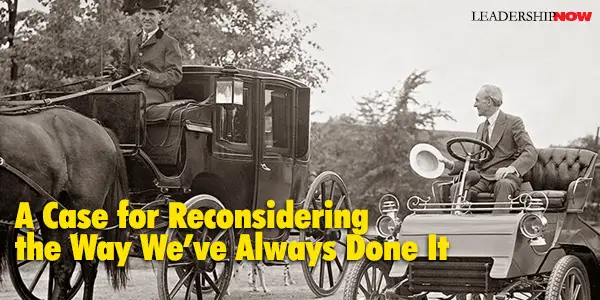
S SOCIETY that doesn’t train their children to think critically, to be aware of those around them, and to serve, must create more rules and regulations than can be accounted for. There will never be enough rules—there are too many variables—especially when people begin to direct their creativity in dysfunctional ways. The challenge is to develop sound minds. As Kant determined, a person with a sound mind is one that can think for oneself, is able to place oneself in the place and viewpoint of others, and can think consistently and coherently. But it‘s easier, in the short term, to create rules. And we pay a price. To be sure, I am not advocating anarchy—we absolutely must have rules—and some rules unquestionably make possible the learning process, but when the rules we have in place reflect our lack of engagement, they become disrespectful and de-motivating. It’s easier to lay down the law or set up a checklist than it is to explain the why; to communicate where we’re headed with this idea. From time to time, it is good to think about the rules we have created (or have had handed down to us), that are impeding progress, relevance, imagination, and growth both for ourselves and others. Here are a few thoughts to guide that process: I am a big advocate of tradition, but when “that’s the way we’ve always done it” or “that’s how I learned to do it” gets in the way of relevance or growth, we need to take a step back and reconsider our stand. What we have done may have served us well in a particular place and time, but may only be an irritation here and now. Rules can reveal a lack of trust. “I don’t trust you to be as smart—considerate or creative—as I am.” And they never will be if not given the chance. As leaders, we need to be aware of where we are blanketing people with rules and procedures that do nothing more than to serve us and not the people it is our intention to serve. We need to consider that perhaps we have implemented rules to create a comfort zone for ourselves. A world where people act and think like we do. A world of clones. A world on autopilot that requires less of us. Often our need for rules and procedures is just masking our fear of the unknown. Our attempt to manage a world that is changing faster than we are learning. No leader can do it on their own and rules are no substitute for not trusting, growing and building relationships with people. Where are we hiding behind rules? Rules, for the most part, do not leverage other people’s strengths and thinking, they mostly mirror our own. Given the chance, people will surprise us with new, different, and better ways to push our agenda forward.
Posted by Michael McKinney at 11:43 AM
03.07.11

This Might Not Work! Start anyway. Poke the Box.Building on the ideas he first presented in Linchpin, Seth Godin is back encouraging us to start things—start a project, make a ruckus, take what feels like a risk. Poke the Box is about seeing what happens.“The box,” writes Godin, “might be a computer or it might be a market or it might be a customer or it might be your boss. It’s a puzzle, one that can be solved in only one way—by poking. When you do this, what happens? When you do that, what happens? The box reveals itself through your poking.” Godin says the opportunity is in creating unique learning experiences that are worth sharing. He advises that we start and keep staring until the project is finished. Failure is a part of starting anything worthwhile. “If you can’t fail, it doesn’t count.” Here are a few more bits of Godin wisdom: Look for the fear. That’s almost always the source of your doubt.Godin notes, “I’ve had a lot of practice in poking the box, figuring out which ideas resonate, and then shipping them. The more you do it, the more it gets done and the less crazy you feel.” He also cautions, “Poke. But be smart about it.” Poke the Box is an effective and convincing book, but more importantly, if applied, is transformational. As you might expect from Godin, Poke the Box: The Workbook is available as a free download on the Domino Project web site. 
Posted by Michael McKinney at 12:30 AM

Don’t Wait for the Clouds to Part. Get Going.Creating and producing is mostly a matter of getting out of the rut, allowing the process to guide you, letting go of perfection, and showing up. Consistently. Daily.Chuck Close, renown American photorealist painter and photographer, says that in his work, so much is embedded in the process of following the path wherever it leads. The important thing is to get going. He said: "If you wait for clouds to part and be struck in the head with a bolt of lightning, you're likely to be waiting the rest of your life. But if you simply get going something will occur to you."
Posted by Michael McKinney at 12:24 AM
03.01.11

First Look: Leadership Books for March 2011Here's a look at some of the best leadership books to be released in March.




For bulk orders call 1-800-423-8273  Build your leadership library with these specials on over 155 titles. All titles are at least 40% off the list price and are available only in limited quantities. The Reagan leadership classic, Reagan on Leadership by James Strock, is once again available in a revised and updated edition. Tom Peters, the legendary leadership authority, has penned an insightful, delightful, highly personal foreword, putting Reagan's historical standing into context. As Mr. Peters points out, the Reagan leadership approach holds down-to-earth, actionable lessons for anyone in their work and life. Reagan on Leadership also includes a new readers' note. Strock surveys recent scholarship and histories of Mr. Reagan's career. Newly released information confirms much of what was already apparent to those who would look; what is evolving is our understanding and appreciation of his leadership legacy. Also available on Amazon. “My early and invincible love of reading, I would not exchange for the treasures of India.” —Edward Gibbon, Memoirs of My Life and Writings
Posted by Michael McKinney at 12:08 AM
|
BUILD YOUR KNOWLEDGE


How to Do Your Start-Up Right STRAIGHT TALK FOR START-UPS 
Grow Your Leadership Skills NEW AND UPCOMING LEADERSHIP BOOKS 
Leadership Minute BITE-SIZE CONCEPTS YOU CAN CHEW ON 
Classic Leadership Books BOOKS TO READ BEFORE YOU LEAD |
|